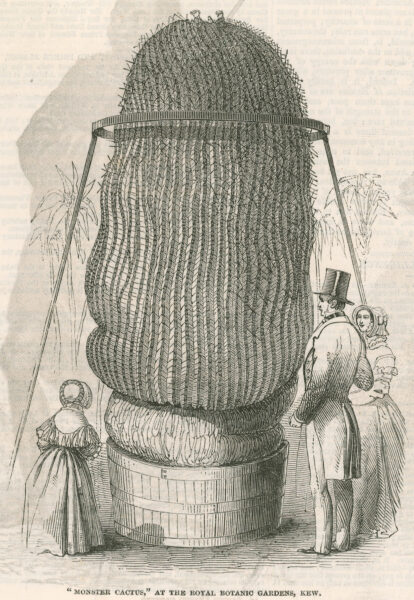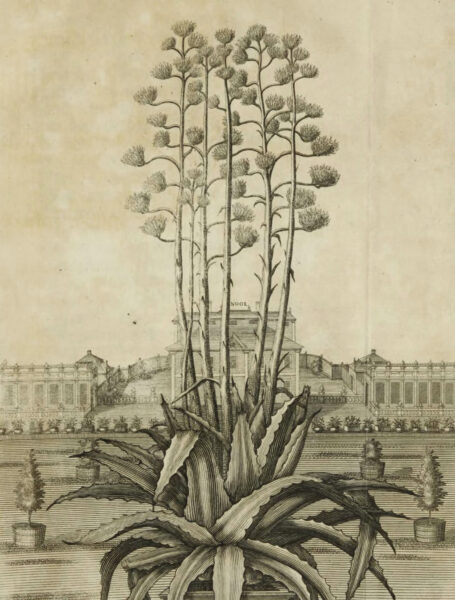Exoticism
Imaginary Exoticism and the Cactus
Long before humans existed, plant life developed a pathway for self-sustaining food production that beat the odds in the hottest, driest conditions on Earth. The food production process of the cactus, called crassulacean acid metabolism, or CAM photosynthesis, evolved to push the boundaries of where and when the plants could live and grow, making them highly specialized and unique to the world’s drylands. The distinct habitat requirements of cacti made them inherently foreign to European conditions, and the plant became a marker of the Continent’s interactions with places far beyond its borders. Although cacti evolved millions of years before humans formed opinions about them, the ancient plants became a proxy for concepts of the exotic, humanity’s proximity to nature, and the types of beings that deserve appreciation and, therefore, care. European attitudes to cacti in particular have tracked the progress of colonization and the concept of race, making these plants unwitting aides in the process of turning the human communities who share their habitats into an easily discarded other.
During the late fifteenth century, two intertwined processes were unfurling out of Western Europe and across the globe. Centuries of “exploration” had established maritime travel as a power that sliced portals through space and time, extending the reach of European economies far beyond the Continent. As Europeans sought new lands to explore and exploit for resources, like the fertile soil of the West Indies for growing cotton, sugarcane, and coffee and Africa’s western coast for mining ore and gold, they also encountered human communities from whom they learned how to name, source, and apply these natural resources.
Indigenous communities across the Earth’s drylands held countless generations of knowledge that, when used toward colonizing agendas, made exploration safer and more profitable for Europeans. A deep understanding of and relationship with cacti continues to be a matter of survival and spirituality for Indigenous communities across the globe. Due to their unique process of photosynthesis, cacti are able to conserve and store water in their thick, waxy structures, making these plants vital providers of sustenance to a web of species. The Diné and the Caxcan, Indigenous peoples of what is now Arizona and Mexico respectively, engaged sustainably with the cacti in their shared habitats. The cacti provided them with pigments, fiber, and entheogens for spiritual experiences and were cosmological guideposts in origins stories.[1] In contrast, European colonial scientists and plant collectors viewed cacti and other foreign plants as collectibles and commodities, selling these culturally and ecologically significant plants as status symbols. Normalizing colonial European relationships with plants—a dynamic of observer and observed, user and used—lowered the value of deep Indigenous relationships with organisms like cacti. By establishing humans and plants as fundamentally distinct things, European scientific views on plant-human interactions became proxies for how evolved, civilized, and ultimately how “human” different groups of people were. These views became part of a powerful set of ideas that contributed to one of the most salient European inventions: the concept of race.[2] The idea that groups of people are fundamentally different and hierarchical suffused the logic and machinery of all colonial projects, including the hunt for plants like exotic cacti.
In most of Western Europe, cacti do not exist. The extreme foreignness of cacti—their appearance, their ability to adapt to intense sunlight and dry conditions—perhaps drove the fascination and demand for cacti among Western Europe’s elite. An awareness of distant colonies without the ability or willingness to interact with them may have influenced the desire for and value of exotic cacti collections. The dry, spiny forests of the West Indies were among the first to be probed by naturalists—the early university and museum biologists who accompanied crews of mercenary explorers and administrators to catalogue new organisms and “civilize” new lands. On their return, these bands of men were to bring new resources back to what they perceived as the heart of civilization—Western Europe. Botanical collections in Europe began featuring cacti as early as the sixteenth century, when the Opuntia cactus, known as prickly pear, was imported for collections and as a food source for the cochineal insect, the females of which are harvested to make a red pigment.[3] The distinctive look of cacti and the particular habitat they need in order to grow made them a specialty item more associated with rarity than with the lands from which they were taken.[4] Conversely, the cactus’ home landscapes were viewed as inhospitable and only fit for lesser races of humans—people who, when the invention of race was applied, deserved to be tamed into submission or simply violently exterminated, but never brought back to Europe as highly-prized treasures.[5]

The most powerful Europeans regarded cacti as priceless and astounding while inventing deadly stories about the very people with whom the alien plants enjoyed a shared provenance.[6] The story of race became an essential tool for dominating people and lands beyond European borders while rarefying ideas about exotic plants. If non-White people were not human like Europeans, but something lesser and ungodly, anything done to or taken from them could be justified. Plants novel to Europe were uprooted from their contexts and placed in spaces like museums, arboretums, private collections, and eventually modern flats and homes, where they existed without the ecosystems they once shared with these oppressed and othered people overseas. The exoticizing and valuing of plants has been commensurate with the racializing and devaluing of people. The physical presence of non-native plants in Europe as signifiers of wealth, status, domesticity, culture, and sexuality worked to elevate the colonial project, producing smooth conceptual surfaces, cleansed of “savage” human others, onto which European ideas about nature, nobility, biology, scientific rigor, and colonial virtue were projected. Unwittingly, plants like cacti, through the happenstance of their biogeography and evolutionary history, went from growing wild and moored in their natural habitats to growing largely in the imaginations of white Europeans, where they continue to thrive today alongside ideas of distant racial others.

Cultural representations of value, like the rarity of a cactus plucked from its arid habitat and forced into the cultural institutions and collections of wealthy Europeans, propagate widespread ideas about the separateness of plants and nature from the human communities who have coexisted with them for millennia. These illusions of value, like a mirage that can never be touched, convey power without ever having a logical grounding in either biology or lived experience. Colonial fantasies transform the physical realities of people and more-than-human organisms. The reality for indigenous communities like the Taino and, later, for enslaved Afro-Caribbeans was that their exoticness to Europeans was valued only to the extent that they could enrich Europe and maintain the falsehood of superiority. Beyond this use, the humanity of non-Europeans threatened the ability of European institutions to characterize and assign value to the world they called new. The technology of race still regulates who is perceived as valuable and, by extension, worthy of safety and protection.[7] In the twenty-first century, cultural media, scientific enterprise, and political economy are imbued with the same ideas that once made the cactus a treasure while making the African a slave. The present urgency to save charismatic plant and animal biodiversity from mass extinction is inconveniently intertwined with the disproportionate threat of climate death hanging over non-white populations globally. Climate change has hastened the shrinking of the imaginary gap between the exotic and valuable plant worth saving and the racialized other worth ignoring, or worse. Art, science, and civic structures now stand in this colonial gap and hold the opportunity to destroy exoticism in favor of a deeper empathy for the human and more-than-human world.
- ↑ Paul G. Zolbrod, Diné bahan’: The Navajo Creation Story (Albuquerque: University of New Mexico Press), 1984; Daisy Ocampo, “Spiritual Geographies of Indigenous Sovereignty: Connections of Caxcan with Tlachialoyantepec and Chemehuevi with Mamapukaib” (PhD diss., University of California, Davis, 2019).
- ↑ John S. Allen, “Franz Boas’s Physical Anthropology: The Critique of Racial Formalism Revisited,” Current Anthropology 30, no. 1 (February 1989): 79–84. Online: www.jstor.org/stable/2743310.
- ↑ R. A. Donkin, “Spanish Red: An Ethnogeographical Study of Cochineal and the Opuntia Cactus,” Transactions of the American Philosophical Society 67, no. 5 (1977): 1–84. DOI: 10.2307/1006195.
- ↑ Christopher M. Parsons, “Plants and Peoples: French and Indigenous Botanical Knowledges in Colonial North America, 1600–1760” (PhD. diss., University of Toronto, 2011).
- ↑ Stephen Gasteyer and Cornelia Flora, “Modernizing the Savage: Colonization and Perceptions of Landscape and Lifescape,” Sociologia Ruralis 40, no. 1 (2000): 128–49.
- ↑ Londa Schiebinger, Plants and Empire: Colonial Bioprospecting in the Atlantic World (Cambridge, MA: Harvard University Press, 2004).
- ↑ Daniel Faber and Christina Schlegel, “Give Me Shelter from the Storm: Framing the Climate Refugee Crisis in the Context of Neoliberal Capitalism,” Capitalism Nature Socialism 28, no. 3 (2017): 1–17. DOI: 10.1080/10455752.2017.1356494.